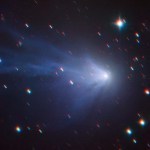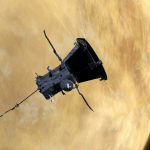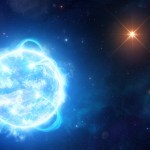Dominique Luchart's Blog, page 619
May 20, 2021
Metals found in the atmospheres of comets in and beyond our solar system surprise scientists, ,

Metal atoms have surprisingly been discovered in the frigid atmosphere of the first known interstellar comet to visit our solar system, a new study finds.
Astronomers have also detected metal in the cold haloes surrounding comets local to the solar system, which suggest our solar system comets and the interstellar visitor may have similar origins, researchers add.
Comets, which are made up of dust and ice left over from planetary formation, could yield key clues to the chemistry of early planetary systems. Scientists often deduce the composition of comets by examining the clouds of gas and dust known as comas that surround the hearts of comets.
Video:
Comets in our solar system surprisingly emit heavy metal vapors
Related:
Future interstellar comet? Gas-spewing object spotted in asteroid group near Jupiter
[image error]
This image of comet C/2016 R2 (PANSTARRS) was captured from ESO’s SPECULOOS telescope at the Paranal Observatory in Chile. (Image credit: ESO/SPECULOOS Team/E. Jehin)Scientists typically do not detect metals such as nickel in the comas of comets, since their surfaces are usually too cold for metal to vaporize. Exceptions to this rule are comets passing near or plunging into the sun, when temperatures can readily exceed the 800 degrees Fahrenheit (425 degrees Celsius) needed for nickel vapor to form.
Now scientists have detected nickel atoms in the coma of the first known interstellar comet, 2I/Borisov. First discovered in 2019, its speed and trajectory revealed it was a rogue comet from interstellar space, making it the first known interstellar comet and the second known interstellar visitor after the pancake-shaped shape rock 1I/’Oumuamua.
The discovery was unexpected — when astronomers first saw these nickel atoms in January using the Very Large Telescope in Chile, 2I/Borisov was far from the sun, with an estimated temperature of minus 135 degrees F (minus 93 degrees C). They detailed their findings in the May 20 issue of the journal Nature.
[image error]
The detection of the heavy metals iron (Fe) and nickel (Ni) in the fuzzy atmosphere of a comet are illustrated here using the spectrum of light of comet C/2016 R2 (PANSTARRS) superimposed on a real image of the comet taken with the SPECULOOS telescope. White peaks in the spectrum represent different elements, with those for iron and nickel indicated by blue and orange dashes, respectively. (Image credit: ESO/L. Calcada/SPECULOOS Team/E. Jehin, Manfroid et al.)In an independent study also appearing in the May 20 issue of Nature, astronomers discovered gaseous nickel and iron in the cold comas of about 20 solar system comets of many different types. The wavelengths of light from these metals they detected using the Very Large Telescope were hidden in plain sight, mingled among the spectrum of light from other molecules in the comas.
The amount of iron and nickel these comets released was small — only about 1 gram per second, compared with the roughly 220 lbs. (100 kilograms) of water per second the comets produced. Coincidentally, the amount of nickel these comets each produced per second was almost exactly the nickel content of a U.S. five-cent coin, or nickel.
“Usually there is 10 times more iron than nickel, and in those comet atmospheres we found about the same quantity for both elements,” Damien Hutsemekers, a researcher with the University of Liege and co-author of the study, said in a statement. “We came to the conclusion they might come from a special kind of material on the surface of the comet nucleus, sublimating at a rather low temperature and releasing iron and nickel in about the same proportions.”
[image error]
The detection of nickel (Ni) in the fuzzy atmosphere of the interstellar comet 2I/Borisov is illustrated here, with the spectrum of light of the comet on the bottom right superimposed on a real image of the comet taken with ESO’s Very Large Telescope in 2019. The lines of nickel are indicated by orange dashes. (Image credit: ESO/L. Calcada/O. Hainaut, P. Guzik and M. Drahus)As to why astronomers overlooked metal atoms in these cometary atmospheres even though the spectrums of light from many of them were visible for the past 20 years, “probably, until now, none of the observers who saw these spectral signatures of nickel or iron could even imagine that gaseous metals might be present in such a cold environment, and left them unidentified,” Piotr Guzik, an astronomer at Jagiellonian University in Krakow, Poland, who co-authored the study concerning 2I/Borisov, told Space.com.
It remains uncertain how all these comets can generate metal at such cold temperatures. One possibility is that harsh ultraviolet light from the sun might break apart nickel-containing molecules in the comets.
All in all, “the fact that even such a minor constituent as nickel is present both in the coma of interstellar comet Borisov and comets observed in the solar system suggests similar conditions at the time and place of their birth,” Guzik said.
Follow Charles Q. Choi on Twitter @cqchoi. Follow us on Twitter @Spacedotcom and on Facebook.
The post Metals found in the atmospheres of comets in and beyond our solar system surprise scientists, , appeared first on NEWDAWN Blog.
Venus views from NASA sun probe show potential of hitchhiking science instruments, ,

Halfway through a series of opportunistic Venus observations, scientists say that a NASA sun spacecraft’s success studying our strange neighbor will pave the way for future measurements.
NASA’s Parker Solar Probe launched in August 2018 on a seven-year mission to touch the sun, dancing through our star’s corona, the sun’s superhot atmosphere that is invisible but shapes conditions across the solar system. That mission requires a trajectory creeping closer to the sun’s visible surface with each flyby, achieved by a series of seven swings past Venus. So, before Parker Solar Probe launched, atmospheric scientists made a case for why the spacecraft’s scientific instruments should be turned on during Venus flybys. Now, after just four of those Venusian maneuvers, the project’s success may point to a new way of studying Venus.
“I’ve just been really, really impressed with how excited people are for any observations at Venus,” Shannon Curry, a planetary physicist at the University of California, Berkeley, told Space.com.
Related: NASA’s Parker Solar Probe captures stunning Venus photo during close flyby
Venus hosts just one full-time robotic explorer these days, Japan’s Akatsuki mission, and the planet has received surprisingly few recent spacecraft visitors, considering the world is just next door to Earth. So scientists jumped at this opportunity for new observations.
Because Parker Solar Probe is optimized to study the sun, not a planet, the project’s success in gathering this extra Venus data can show the feasibility of using clever mission operations techniques to turn trajectory maneuvers into science opportunities. The U.S.-European Solar Orbiter spacecraft and the European-Japanese BepiColombo mission to Mercury also require Venus flybys to steer to their destinations, and Curry said she and colleagues are working with both mission teams to guide potential observations based on how similar instruments aboard Parker Solar Probe have performed.
“We give each other a heads up on like, ‘Here’s what to look for, here’s how you can get the best science,'” Curry said. “All of us have sort of gotten on the bandwagon of let’s make these flybys count.”
However, because the instruments that scientists are “borrowing” to observe Venus are fairly small, similar equipment could also find a home on full-fledged Venus missions to round out scientists’ understanding of the phenomena that Parker Solar Probe and others can study only briefly.
“A lot of these particle and fields instruments are pretty light,” Curry said. “These are sort of shameless advertisements for saying, like, ‘Hey, it’s not that hard to add this.'”
NASA isn’t committed to any Venus-specific spacecraft right now, but there are a host of potential missions to the planet under serious discussion, including two projects NASA may select later this spring and mission concepts that Europe, India and the U.S. company Rocket Lab are considering. Scientists have also evaluated what they could learn with a Venus mission at the scale of NASA’s so-called “flagship missions,” like its Mars rovers.
Dedicated Venus spacecraft tend to focus on questions about the planet’s surface and thick atmosphere, rather than untangling how the planet’s atmosphere interacts with its surroundings and with the sun, as Parker Solar Probe is doing.
But the distinction between studying Venus and studying its relationship with the surrounding environment isn’t as clear as all that. For example, if scientists want to learn about, say, how the Venusian atmosphere and its potential habitability may have changed over the planet’s history, it’s helpful to know what ingredients in its modern atmosphere are slipping into interplanetary space, and how quickly.
And that’s the sort of observation that Parker Solar Probe has aced, Curry said.
In particular, she’s been pleased with the data the probe has gathered about what types of charged particles are traveling in the transition zone between the Venusian atmosphere and interplanetary space and how quickly those particles are moving. Previous missions, like NASA’s Pioneer Venus Orbiter and the European Space Agency’s Venus Express, have studied these charged particles, but could only estimate their identity and speed. Instead, Parker can identify particular flavors of ions and clock their movements.
“We have a much, much better picture,” Curry said of the new Parker Solar Probe observations compared with data from much older, dedicated Venus missions. “It’s like those photos in the 1900s where things are a little blurry and everybody’s sort of sitting very, very still. And now we actually have sort of like the live iPhone photos.”
Parker Solar Probe’s observations have also revealed a host of tiny, short-lived phenomena in Venus’ electric and magnetic fields. “These are really, really, really tiny things,” Curry said of these detections. “But we finally effectively have like a microscope there that we can start to understand these sorts of things with, and we’ve never had anything close to that.”
Moreover, some of these observations are the first detections of such phenomena at a world besides Earth. Curry said such detections should help scientists begin to understand what is unique to our world and what may, in fact, be common across the solar system.
So far, Parker Solar Probe is painting a picture of magnetic and electric fields, charged particles from the sun and from the planet, and other phenomena interacting in a way that’s very different from what scientists had expected, which was a straightforward teardrop-shaped bubble.
“We now know that it’s a significantly more complex and complicated interaction,” Curry said, “in a really good way, like in a fun, complicated way.”
Meanwhile, Parker Solar Probe still has three more Venus flybys of its own to execute: one in October, then a pair in 2023 and 2024. The last flyby, in November 2024, will occur near the end of Parker Solar Probe’s mission and near the peak of the solar cycle, and it will pull the spacecraft into the bubble-like bow-shock surrounding Venus, just as the two most recent flybys did.
“[Flyby number] seven’s just going to be a beast,” Curry said. “I’m super excited for it.”
Follow us on Twitter @Spacedotcom and on Facebook.
The post Venus views from NASA sun probe show potential of hitchhiking science instruments, , appeared first on NEWDAWN Blog.
Some of the universe’s stars have gone missing. But where did they go?, ,

Stars don’t just vanish — or do they? For thousands of years, astronomers accepted the idea that the lights in the sky were fixed and unchanging. Even when it became clear that these lights were actually physical objects like the sun, one of the key assumptions for astrophysicists has been that they go through major changes very slowly, on timescales of millions or billions of years.
And when the most massive stars of all — which are many times heavier than the sun — do go through sudden and cataclysmic changes as they reach the ends of their lives, their passing is marked by the unmissable cosmic beacon of a supernova explosion, which shines for many months, and may even be visible across hundreds of millions of light-years.
But what if some stars suddenly just wink out of visibility? According to everything we know about stars, that should be impossible, but over the past few years, a group of astronomers has set out to see whether such impossible things do happen, comparing data across decades of observations.
Related: How Can a Star Be Older Than the Universe?
All About Space
[image error]
(Image credit: Future)This article is brought to you by All About Space .
All About Space magazine takes you on an awe-inspiring journey through our solar system and beyond, from the amazing technology and spacecraft that enables humanity to venture into orbit, to the complexities of space science.
“VASCO is the Vanishing and Appearing Sources during a Century of Observations project,” said Beatriz Villarroel of the Nordic Institute for Theoretical Physics, Sweden. “We’re actually interested in all kinds of vanishing objects, but ideally I’d like to find a star that’s been steady and has been there in the sky for as long as we can remember and as long as we have data for, and one day it just vanishes. And you can point the biggest telescopes in the world at it and still see nothing there.”
Since Villarroel and her colleagues began work on the project in 2017, they’ve attracted a lot of attention from scientists who see the potential in searching historic records: “We have astronomers from all kinds of different fields interested in the project — specialists in active galactic nuclei [the power source of intensely brilliant quasars in the distant universe], stellar physicists, and SETI [Search for Extraterrestrial Intelligence] scientists — everyone has their reasons for getting involved.”
[image error]
Massive stars can destroy themselves in supernovas, but these are hard to miss, outshining entire galaxies for several months and leaving behind superheated remnants. (Image credit: NASA, ESA)Although our current understanding suggests that stars change only very slowly, and dramatic disappearances should leave traces behind, that’s not to say that all stars shine steadily. In fact, the sky is packed full of variable stars that pulsate and change in brightness. Villarroel emphasizes that VASCO is about something different. “We know that there are variables, but their timescales tend to be a few years at most. We want to find something that goes from a completely steady star to just vanishing entirely — this hasn’t been documented, and it’s the kind of discovery that could lead to new physics.”
Cataloging the skyRecent years have seen the development of automated telescopes that can catalog the entire sky at a rate that previous generations of astronomers could only dream about. For instance, the Zwicky Transient Facility (ZTF) at Mount Palomar in California combines a state-of-the-art camera with the venerable Samuel Oschin Telescope.
Its ultra-wide field of view enables it to survey the entire Palomar sky over just three nights, scanning the plane of the Milky Way twice each night. This massively increases the likelihood of detecting the chance eruptions known as transients — bursts of light that can be caused by intense stellar flares on distant stars, but may also be associated with some of the most violent and rare events in the universe, such as mysterious gamma-ray bursts.
However, there’s a big difference between looking for stars that appear, and those which disappear, as Villarroel highlights: “Projects like the ZTF work on very short timescales, but if you have a very rare event where something vanishes from the sky every 100 years then you really need a very long timescale to pick it up. In our case we want to find a star that has vanished — or actually appeared — using as large a time span as possible, combined with the best catalogs from older times.
We’re using data from 70 years ago and comparing it to data from today to see how the sky might have changed.” Perhaps ironically, the team’s search for high-quality historical data led researchers back to Palomar and the Samuel Oschin Telescope, which in the 1950s produced the photographic plates for an all-sky survey that has since been scanned by the US Naval Observatory (USNO). For a modern counterpart they relied on data from the twin telescopes of the Panoramic Survey Telescope and Rapid Response System (Pan-STARRS) at Hawaii’s Haleakala Observatory.
[image error]
The USNO survey plates predate the Space Age, and exposures are long enough to distinguish asteroids as short trails against stars. (Image credit: ESO)“All of these surveys are freely available, and everything has been digitized and is online,” said Villarroel. “Our IT team at Uppsala University has developed a citizen science webpage where you can click and combine images at ml-blink.org. We have computer game developers who have looked at making the design more appealing, and we also have an AI in development.
There are several different ways of approaching the problem — whatever gives us data! The point is that people who are interested can go there to compare the images, and if they are very curious about some case they can leave a comment, and we’ll get back to them and inform them about their candidate. But we have quite a lot of work ahead of us before we can follow up on everything.”
Every object in the USNO catalog that is flagged as having no obvious counterpart in the Pan-STARRS data has to be examined and confirmed by the team. Researchers then look at the shape, brightness, and other characteristics to identify whether it is a defect on the photographic plates of the original survey.
“You can never guarantee it’s not a plate defect,” said Villarroel. “But you can do some tests in order to eliminate the most obvious things. Then you go to the deeper catalogs like the Sloan Digital Sky Survey (SDSS) or the new Dark Energy Camera Legacy Survey to see if you can find any remains of the object on these, and depending on what you find that might give you different types of candidates.”
The team also compares candidates with data from the European Space Agency’s Gaia, which is currently busy gathering precision data for more than a billion stars in the Milky Way.
Related: Star ‘Families’ Stick Together in the Milky Way, Gaia Maps Reveal
[image error]
The VASCO researchers use data from the European Space Agency’s Gaia space observatory to double-check candidate “missing” stars. (Image credit: ESA)So far, the survey has delivered more than 800 apparently ‘missing’ stars, many of which still need to be processed and studied in depth. And while there’s no perfect match for Villarroel’s ideal object — a vanishing act by a long-lived, stable star –many of the candidates that have been spotted are still intriguing in their own right.
“We have found a number of short-lived transients that appear on one image, and then not again. Those account for most of what we’ve found so far, but there are other things we’re not sure of what they are yet. We’ve studied some of these short-lived transients, and they don’t seem to be M-dwarf flares [the huge outbursts caused by the tangled magnetic fields of faint red dwarf stars that may cause them to brighten by a factor of 100 or more], or any type of supernova. I think we can start excluding those options.”
Other options that seem unlikely include variable stars and cataclysmic variables or novae — eruptions on the surface of white dwarf stars in binary systems. None of the sources sit close to a known variable, and the companion star in a nova system ought to be faintly visible on some of the modern surveys, even when the white dwarf isn’t.
[image error]
Ageing red giant stars can “disappear” as they shed their outer layers and evolve into white dwarfs, but the process takes hundreds of thousands of years and produces a distinctive planetary nebula. (Image credit: NASA, ESA)“One possibility is that they could be some kind of optical afterglow from gamma-ray bursts or fast radio bursts,” Villarroel said. The sources of these high-energy cosmic eruptions are still poorly understood, but one common prediction is that as their energy output dwindles, they should pass through a brief period of visibility.
“Such outbursts are predicted to have super-big amplitudes of about eight to ten magnitudes, but fade in just a few minutes, and don’t seem to have any kind of visible counterpart when we look at the locations with big telescopes. Of course, with 800 candidates we still have a lot of work to do, and I think to be clear it’s almost certainly a mixed bag of objects of different types,” she said.
If those 800 candidates turn out to contain an ideal vanishing star, what could be the possible explanation?
One option might turn out to be a so-called “failed” supernova — a truly monstrous star with a core so massive that it collapses into a black hole and consumes the rest of the star from the inside out, cutting off the torrent of nuclear fusion that normally accompanies a supernova explosion and leaving no visible remnant behind.
[image error]
Black holes can form at the center of stars in the Milky Way. (Image credit: Getty Images)However, Villarroel thinks that the odds are stacked against this explanation — she calculates that such events should happen about once every three centuries in our galaxy, making it unlikely that the VASCO project would stumble upon one by chance.
At the moment it’s hard to imagine other natural processes that might result in a star simply disappearing — and until a candidate emerges with features that can be studied, there’s little point in speculating on possible new physics that might be involved in this cosmic vanishing act. However, that raises one other possibility that’s inspired VASCO from the outset: The idea that apparently impossible astronomical events might give away the existence of advanced alien civilizations.
Potential future discoveries[image error]
The Pan-STARRS survey telescopes at Haleakala Observatory on the Hawaiian island of Maui. (Image credit: Getty Images)As increases in telescope size and sensitivity, coupled with computing power, have brought astronomy into its “big data” era, many SETI scientists have argued that we’re more likely to detect the presence of aliens through the otherwise-inexplicable behaviors of stars and other objects than we are from radio signals deliberately or accidentally beamed in our direction by alien life.
The theory is that if civilizations become sufficiently advanced, at least some of them are likely to develop the technology required for stellar engineering, which would alter the appearance of stars in otherwise-inexplicable ways. A classic example of this is the “Dyson sphere” — a halo of orbiting power plants that would be the most efficient way of extracting energy from a star.
Related: ‘Dyson sphere’ legacy: Freeman Dyson’s wild alien megastructure idea will live forever
[image error]
A really advanced alien civilization could cause stars to disappear in a number of ways — perhaps blocking out their light by surrounding them with Dyson spheres. (Image credit: Alamy)Science-fiction author Arthur C. Clarke stated in his Third Law that “any sufficiently advanced technology is indistinguishable from magic”. If no natural cause for a stellar disappearance could be found, then the influence of intelligent extraterrestrials would certainly seem a more likely explanation than the supernatural.
“With regard to SETI, there are several different ways of thinking about it,” Villarroel said. “Dyson spheres and other structures, beacons that are turned on and off, or point in our direction for a certain time, or maybe there are ways for a civilization to actually get rid of stars that are getting in the way.”
Even the red transients that the team has identified so far could have a possible artificial cause: “Of course, the first hypotheses we go for are natural ones — and we don’t have any reason to exclude those yet — but if I was in my extraterrestrial speculation mode, I guess a laser beam could also produce a red transient of this type.”
[image error]
One extraordinary possibility is that the disappearing “stars” are actually huge starships moving through space, in which case they might not be missing, but moving. (Image credit: Getty Images)While Villarroel hints at exciting discoveries that have already emerged from the data and await formal publication, in the meantime the VASCO project continues. Many of the candidates identified so far still await proper confirmation and analysis, and only a quarter of the sky has actually been checked so far. Further progress will hopefully be accelerated by more volunteer citizen scientists and new automation methods currently being developed in collaboration with the Spanish Virtual Observatory.
“We don’t know of any processes where a star would just vanish, except for this hypothetical failed supernova,” Villarroel reflects. “Therefore vanishing stars become interesting because we haven’t observed such things in nature. The main principle was to look for things we would think of as being impossible.”
The post Some of the universe’s stars have gone missing. But where did they go?, , appeared first on NEWDAWN Blog.
Google rediscovers RSS: tests new feature to ‘follow’ sites in Chrome on Android,

Google is testing a new feature for its Chrome browser on Android that lets users “follow” sites to create an updating list of new content they publish. The feature is based on RSS, an open web standard that’s been the backbone of many popular web aggregation tools in the past. That includes Google’s own, much beloved (and now defunct) Google Reader.
The test is small-scale: following sites will only be an option for some US users of Chrome Canary (the bleeding-edge version of Chrome that lets enthusiasts access beta features). Users will be able to follow sites from the browser menu, and updates will be aggregated in a card-based feed that’s shown when users open a new tab. It’s not clear whether this feed is wholly dependent on sites providing RSS support, or if Google will fill in the gaps itself.
Although this is just an early test, it’s nonetheless exciting for a certain sort of web user who misses the glory-days of RSS (and, by extension, a mode of internet discovery and distribution that faded years ago). At its core, RSS allows users to maintain a personalized feed of new content from favorite sites, blogs, and podcasts. And although tools that utilized these feeds were briefly very popular, they were eclipsed for numerous reasons.
Exactly why RSS fell from prominence is complicated. (Here’s a story from Vice and one from TechCrunch that help explain.) But whatever the ultimate cause, many see its demise as a turning point for the web: the moment when decentralized, chronological feeds were replaced by the engagement-driven algorithms of social media giants.
 The halcyon days of 2013: the year of Google Reader’s death. Image: The Verge
The halcyon days of 2013: the year of Google Reader’s death. Image: The VergeBecause the rise of Facebook, Twitter, and the like have had so many obviously bad effects (misinformation! Hoaxes! Nazis!), many look back wistfully on RSS as a sort of Golden Age for the web that failed from a surfeit of nobility and deficit of cunning. “If only RSS had thrived!” they say. “All this nastiness could have been avoided.” Perhaps. What’s clear is that Google is responding to a demand for new (read: old) ways of engaging with the web.
“We’ve heard it loud and clear: Discovery & distribution is lacking on the open web, and RSS hasn’t been ‘mainstream consumer’ friendly,” tweeted Google’s head of web creator relations, Paul Bakaus. “Today, we’re announcing an experimental new way, powered by RSS, to follow creators with one click.”
What happens next is anyone’s guess. Will Google follow through and push RSS-powered features to all Chrome users? Or will it get bored of a product that’s not integral to its bottom line? (As it did with Google Reader.) Bakaus, at least, suggests there’s more to come. “This is only the beginning of a bigger exploration, and to get this right, we need your feedback,” he tweeted. “Hit us up via @WebCreators to let us know what we need to build for you. I’m very excited about it!”
The post Google rediscovers RSS: tests new feature to ‘follow’ sites in Chrome on Android, appeared first on NEWDAWN Blog.
Google rediscovers RSS: tests new feature to ‘follow’ sites in Chrome on Android, James Vincent

 Users follow sites through the browser’s menu, with an aggregated feed shown when they open a new tab. | Image: Google
Users follow sites through the browser’s menu, with an aggregated feed shown when they open a new tab. | Image: GoogleGoogle is testing a new feature for its Chrome browser on Android that lets users “follow” sites to create an updating list of new content they publish. The feature is based on RSS, an open web standard that’s been the backbone of many popular web aggregation tools in the past. That includes Google’s own, much beloved (and now defunct) Google Reader.
The test is small-scale: following sites will only be an option for some US users of Chrome Canary (the bleeding-edge version of Chrome that lets enthusiasts access beta features). Users will be able to follow sites from the browser menu, and updates will be aggregated in a card-based feed that’s shown when users open a new tab. It’s not clear whether this feed is wholly dependent on sites…
The post Google rediscovers RSS: tests new feature to ‘follow’ sites in Chrome on Android, James Vincent appeared first on NEWDAWN Blog.
May 19, 2021
Google wants to build a useful quantum computer by 2029, Jon Porter
Google is aiming to build a “useful, error-corrected quantum computer” by the end of the decade, the company explained in a blog post. The search giant hopes the technology will help solve a range of big problems like feeding the world and climate change to developing better medicines. To develop the technology, Google has unveiled a new Quantum AI campus in Santa Barbara containing a quantum data center, hardware research labs, and quantum processor chip fabrication facilities. It will spend billions developing the technology over the next decade, The Wall Street Journal reports.
The target announced at Google I/O on Tuesday comes a year and a half after Google said it had achieved quantum supremacy, a milestone where a quantum computer…
The post Google wants to build a useful quantum computer by 2029, Jon Porter appeared first on NEWDAWN Blog.
May 18, 2021
Nintendo Switch Online reaches more than 100 retro games,

Nintendo has hit a milestone with the ever-growing library of retro games included in its Nintendo Switch Online service. The next batch will take the number of available games past 100, with five new titles resulting in a total of 104.
In keeping with recent form, the latest additions are, well, not necessarily blockbuster releases. Here’s the list:
Caveman Ninja: Joe & Mac, a prehistoric action game released in arcades and ported to the SNES by Data East in 1991Magical Drop 2, a 1996 Data East puzzle game for the SNES that was originally on the Neo Geo but never previously got a Western releaseSuper Baseball Simulator 1.000, a SNES baseball game released by Culture Brain in 1991Spanky’s Quest, a 1991 SNES action game by Natsume about a monkey with a magic bubbleNinja JaJaMaru-kun, a popular Jaleco NES action game released in 1985; it was only ever released in Japan but did come to the Wii Virtual Console around the world in 2007So no, still no Earthbound.
Nintendo is, of course, constrained in what it can release on the service for various reasons including licensing issues, and it is cool to see some more obscure titles get spotlighted. But it’s clear that there isn’t much left in the NES and SNES pipeline, and it’d be a good time for the company to start thinking about perhaps moving on to the N64 — especially now that Super Mario 3D All-Stars (which includes Super Mario 64) has been removed from sale forever.
Until that hypothetical possibility transpires, you’ll be able to play the five new games when they’re added to the service on May 26th. Nintendo Switch Online costs $3.99 a month or $19.99 a year.
The post Nintendo Switch Online reaches more than 100 retro games, appeared first on NEWDAWN Blog.
Nintendo Switch Online reaches more than 100 retro games, Sam Byford

 Illustration by Alex Castro / The Verge
Illustration by Alex Castro / The VergeNintendo has hit a milestone with the ever-growing library of retro games included in its Nintendo Switch Online service. The next batch will take the number of available games past 100, with five new titles resulting in a total of 104.
In keeping with recent form, the latest additions are, well, not necessarily blockbuster releases. Here’s the list:
Caveman Ninja: Joe & Mac, a prehistoric action game released in arcades and ported to the SNES by Data East in 1991Magical Drop 2, a 1996 Data East puzzle game for the SNES that was originally on the Neo Geo but never previously got a Western releaseSuper Baseball Simulator 1.000, a SNES baseball game released by Culture Brain in 1991Spanky’s Quest, a 1991 SNES action game by Natsume…The post Nintendo Switch Online reaches more than 100 retro games, Sam Byford appeared first on NEWDAWN Blog.
At the Epic trial, Phil Schiller got away clean,

Phil Schiller is one of the biggest names at Apple, and at the Epic v. Apple trial, his job was to make Apple feel small. Over two days of testimony including several hours of cross-examination, he didn’t always succeed — but he left the stand without facing some of Epic’s harshest lines of attack.
Schiller, whose title is simply “Apple Fellow,” has spent more than 30 years with the company. In his testimony, he recounted joining Apple in the ’90s and watching Steve Jobs reorganize the then-failing computer maker. He reminisced about the iPod and name-dropped largely forgotten competitors like Handango and BlackBerry Messenger. In court, Epic Games has portrayed Apple as a scolding, disingenuous bully that locks users into a walled garden and gets mad at cartoon bananas. Schiller countered with an iOS product showcase and Apple history lesson, and Epic didn’t do much to stop him.
The iPod bit was a great encapsulation of Schiller’s time on the stand. As my colleague Liz Lopatto notes, Schiller famously served as Apple’s longtime marketing head. But at the prompting of an Apple lawyer, Schiller mentioned on Tuesday that he’d also helped invent the iPod clickwheel — one of Apple’s most distinctive hardware designs. And why, Apple’s counsel asked, was a marketing executive working on hardware design? “Product marketing works hand-in-hand with engineering on all of our projects,” Schiller explained. Different parts of Apple simply aren’t siloed into neat divisions; it’s one tight-knit company that makes a many-featured product.
That anecdote buttressed a more legally pertinent claim: because of this management system, Apple allegedly has no idea how much the App Store makes.
One Epic-paid expert witness has pegged Apple’s operating margins between 70 and 80 percent, something Epic calls evidence of monopoly power. Epic used one of Apple’s PR statistics to estimate the App Store made $20 billion or more in commissions by 2017. Schiller didn’t dispute the number. But he said Apple never calculated its overall profitability.
“We don’t deny that it likely is. It’s just that we haven’t managed the business that way,” Schiller said of the App Store. He rattled off iPhone features that require lots of work and benefit App Store developers, but don’t involve spending money on the store itself. Epic attorney Katherine Forrest was incredulous: “Apple can do accelerometers, and machine learning, and have some of the most sophisticated technology around, and it can’t figure out if the App Store is profitable — is that what you’re saying?” Schiller, however, never changed his story.
Apple used Schiller to put a new spin on Epic’s other evidence against it. Epic has cited a 2008 message where he said opening up iOS would mean “throwing out the whole plan” for the operating system. But where Epic described that plan as a single monopolistic gambit, Schiller says he was just describing the straightforward goal of a central App Store.
“You keep going back to that sentence referring to ‘the plan,’ as if there was one special plan that we referred to,” he complained at one point. Where Epic has pointed out phrases like “lock-in” and seeking “stickiness” on iOS, Schiller emphasized that the “stickiness” involved trying to add features that would discourage phishing. “If there’s any plan here, it’s simply to come up with new features to help protect users from security and privacy scams.”
Some choices are tougher to spin as fair-minded altruism. One court filing suggests Apple kept iMessage off Android to discourage switching ecosystems, and another recounts a list of sweetener deals that Apple discussed offering Netflix, despite claims to not favor individual developers. iMessage and the App Store play a huge role in consumer technology, and Epic’s counsel had a chance to push Schiller on them, helping the rest of us better understand how Apple makes these calls.
But mostly, Epic… just didn’t. Cross-examination touched on topics like iMessage, but Epic’s counsel favored exhaustive readings of policies and lists that could show Apple in an unfavorable light, including every time it mentions relying on open source software and the search results for “BDSM” on the App Store. Little of this related to Schiller himself, although we did glean details like his favorite Fortnite skins (Rogue Agent and the New England Patriots), his use of Reddit (“I tried it once”), and whether knows what Pornhub is (allegedly, no.) And while Schiller occasionally sounded frustrated, he stuck to his central claims: the App Store can’t be carved out or measured, and even if it’s made Apple rich, it’s helped everyone else as well.
The post At the Epic trial, Phil Schiller got away clean, appeared first on NEWDAWN Blog.
At the Epic trial, Phil Schiller got away clean, Adi Robertson

 phil schiller wwdc 2013
phil schiller wwdc 2013Phil Schiller is one of the biggest names at Apple, and at the Epic v. Apple trial, his job was to make Apple feel small. Over two days of testimony including several hours of cross-examination, he didn’t always succeed — but he left the stand without facing some of Epic’s harshest lines of attack.
Schiller, whose title is simply “Apple Fellow,” has spent more than 30 years with the company. In his testimony, he recounted joining Apple in the ‘90s and watching Steve Jobs reorganize the then-failing computer maker. He reminisced about the iPod and name-dropped largely forgotten competitors like Handango and BlackBerry Messenger. In court, Epic Games has portrayed Apple as a scolding, disingenuous bully that locks users into a walled…
The post At the Epic trial, Phil Schiller got away clean, Adi Robertson appeared first on NEWDAWN Blog.



